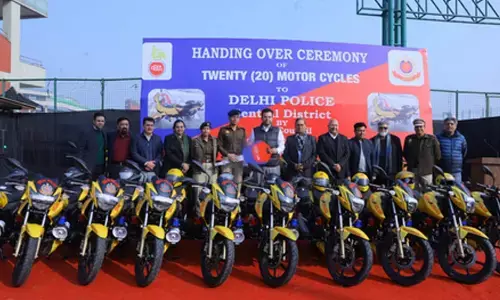Vinayak Narahari Bhave- Architect of Bhoodan Movement

Vinayak Narahari Bhave was born in a village in Maharashtra’s Kolaba district on 11 September 1895. Considered as a ‘national teacher of India’ who left his firm imprint on the religious, social and political consciousness of India, he was highly inspired after reading, at a young age, the Bhagavad Gita. Of the many teachings of the Gita that Vinobaji highlighted in his talks, one of the most important was the role of self-help.
Vinoba’s religious outlook was very broad and it synthesized the truths of many religions. This can be seen in one of his hymns ‘Om Tat’, which contains symbols of many religions. He was associated with Gandhi in his struggle for the freedom of India. In 1932, the government sent him to jail because of his fight against British rule. There he delivered a series of talks on the Gita, in his native language Marathi, to his fellow prisoners.
These highly inspiring talks were later published as the book Talks on the Gita, and it has been translated into many languages both in India and elsewhere, Vinoba felt that the source of these talks was something bestowed from the above and he believed that its influence would endure even if his other works were forgotten.
Vinoba, well read in the writings of Maharashtra’s saints and philosophers at a young age and deeply interested in Mathematics, was attracted to the core of learning. Naturally, the routine course work was not enough to quench his thirst for knowledge. His two years in college remained full of internal uneasiness and agitation.
Early in March 1916, he put his school and college certificate in a fire on his way to Mumbai to appear for the intermediate examination. He took a fateful decision not to reach Mumbai, but to reach Varanasi. This decision was motivated by his longing to attain the imperishable and all pervading Brahma. He got into the study of ancient Sanskrit tests. Vinoba stands as a symbol for the struggle of the good against the evil, of spirituality against the mundane. He was a spiritual visionary, whose spirituality had a pragmatic stance with intense concern for the deprived. He was a brilliant scholar who could be accessible to ordinary people.
He was Gandhi’s ardent follower, who could retain originality in thinking. As Sarvepalli Radhakrishnan pointed out, ‘Indeed his life represents a harmonious blend of learning, spiritual perception and compassion for the lowly and the lost’. In March 1948, Gandhi’s followers and constructive workers met at Sevagram. The idea of Sarvodaya Samaj (society) surfaced and started getting acceptance. Vinoba got busy with activities that would soothe the wounds of the partition of the nation.
In the beginning of 1950, he launched the programme of kanchan-mukti (freedom from dependence on gold, i.e., money) and Rishi-Kheti (cultivation without the use of bullocks as was practised by Rishis, i.e., the sages of ancient times). His Bhoodan (Gift: of the Land) movement started on 18 April 1951, attracting the attention of the world. Untouched by publicity and attention, Vinoba had continued his efforts for a just and equitable society. In fact, his life is a saga of his commitment to non-violent ways of bringing changes, his yearning for the highest level of spirituality and his unwavering faith in human values and love.
He believed in communal amity. In order to know the best mind of Islam, he studied Quran for one year in the original form. He, therefore, learnt Arabic. He found this study necessary for cultivating contact with the Muslims living in the neighbourhood. Vinoba observed the life of the average Indian living in a village and tried to find solutions for the problems he faced with a firm spiritual foundation.
This formed the core of his ‘Sarvodaya’ (Awakening of all potentials) movement. Another example of this is the ‘Bhoodaan’ (land gift) movement. He walked all across India asking the people with land to consider him as one of their sons and so give him a portion of their land, which he then distributed to landless poor. Non-violence and compassion being a hallmark of his philosophy, he also campaigned against the slaughtering of cows.
Vinoba went and met Gandhi on 7 June 1916. This meeting changed the course of Vinoba’s life. He said later. When I was in Kashi, my main ambition was to go to the Himalayas. Also there was an inner longing to visit Bengal. But neither of the two dreams could be realized. Providence took me to Gandhi and I found in him not only the peace of the Himalayas but also the burning fervor of revolution, typical of Bengal. I said to myself that both of my desires had been fulfilled.
He was jailed thrice during 1940-41 in Nagpur jails; for individual Satyagraha first time for three months, second time for six months, and third time for one year. Vinoba was not known nationally when Gandhi selected him for individual Satyagraha. Gandhi had issued a statement on 5 October 1940 introducing Vinoba. It stated: ‘Vinoba believes in the necessity of the political independence of India. He is an accurate student of history.
But he believes that real independence of the villagers is impossible without the constructive program of which khadi is the center’. Vinoba took part in the Quit India Movement in 1942 for which he was jailed for three years at Vellore and Seoni jails.
In April 1951, after attending the Sarvodaya Conference at Shivrampally, near Hyderabad, he started his peace trek on foot through the violence-torn region of Telangana (then in Hyderabad State). For, the Telangana communists were engaged in a bitter struggle with landlords, Razakars and Indian armies thereafter. On 18 April 1951, his meeting with the villagers at Pochampalli in Nalgonda district opened a new chapter in the history of non-violent struggle.
The Harijans of the village told him that they needed 80 acres of land to make a living. Referring to this, Vinoba asked the villagers if they could do something to solve this problem, to everybody's surprise. Ram Chandra Reddy, a landlord, got up and showed his willingness to give 100 acres of land.
This incident, unplanned and unheard, showed a way to solve the problem of the landless. That was the beginning of initiating the historic Bhoodan (Gift of the Land) movement in other parts of India, thereafter. The response to the movement was spontaneous. In Telangana, the gift of land averaged 200 acres of land per day.
On the journey from Pavnar to Delhi, the average gift was 300 acres a day. Vinoba had put 5 crore acres as the target. While walking in Uttar Pradesh in May 1952, Vinoba received the gift of the whole village of Mangrath. This meant the people were prepared to donate all their land for the benefit of the villagers, not as individual bhoodan, but as community Gramdan (Gift of the Village).
Vinoba received 23 lakh acres of land in Bihar, which he covered on foot from September 1952 to December 1954. Orissa, Tamil Nadu and Kerala contributed significantly to Gramdan. Vinoba firmly believed that people are his God. He said, ‘we must establish the independent power of the people— this is to say, we must demonstrate a power opposed to the power of violence an’^ other than the power to punish.
He observed a year of silence from 25 December 1974 to 25 December 1975. In 1976, he undertook fasting to stop the slaughter of cows. His spiritual pursuits intensified as he withdrew from the activities. He breathed his last on 15 November 1982 at this ashram.



















